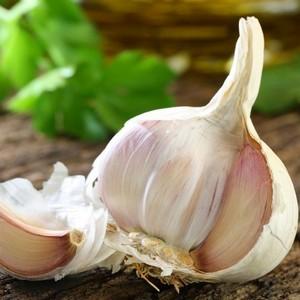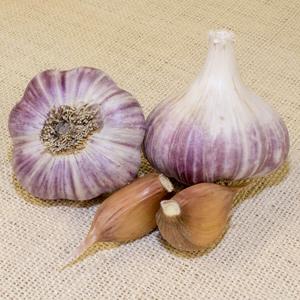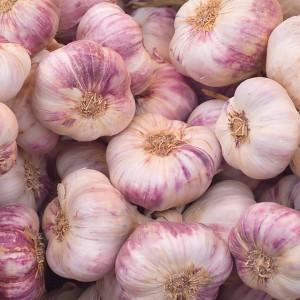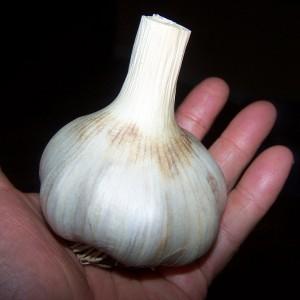Top 30 best varieties of garlic, their photos with descriptions and help in choosing the right variety
Garlic contains many beneficial vitamins, antioxidants, essential oils and has antibacterial properties. The plant is used not only in cooking, but also in folk medicine. That is why gardeners all over the world love to grow it so much.
In this article, we will look at the most popular varieties of garlic and find out which garlic is better - winter or spring. Plus, we bring to your attention a photo with a description of the varieties.
The content of the article
What are the types of garlic
The culture is divided into two broad groups: spring garlic and winter garlic. Each of them has its own advantages and disadvantages. Before planting a plant, you need to carefully study the planting rules for a particular variety. Spring is planted in late or mid-April, winter - mainly in autumn.
What is the difference between spring garlic and winter garlic
The differences are as follows:
- The taste of winter varieties is brighter, so this garlic is more suitable for cooking. This vegetable has a spicy taste and rich aroma.
- Winter varieties can boast of large sizes - the teeth are large, smooth.
- Spring garlic ripens much longer than winter garlic.
- The winter vegetable is more productive - fresh tines can be used already in summer.
- Spring varieties are stored longer - the taste and appearance are unchanged throughout the year. While winter kept only 3-4 months.
- Spring is better tolerated by diseases and parasites.
Important! It is impossible to say unequivocally which variety is better - spring and winter. It all depends on the care and region of residence.
The best varieties of winter garlic
If you decide to plant winter on your site garlic, the following varieties are best suited for this:
- Alekseevsky giant Is one of the favorites in the garlic market. It was bred in 1998 and since then has won the hearts of many gardeners. It is characterized by large teeth, weather resistance, rich harvest. Perfectly stored in room conditions. The bulb weighs about 170 g and consists of 4-5 cloves. Has a sweet-pungent taste.
- Lyubasha - the result of the work of Ukrainian agronomists and farmers. It perfectly tolerates drought and fungal diseases. The ripening period is about 90 days. The plant reaches a height of 1.5 m. One head "lives" from 4 to 7 cloves. Garlic has a spicy taste - for this Lyubasha is appreciated by chefs. The variety is excellent for both fresh consumption and canning.

- Dobrynya - white pale bulbs with purple streaks. The main advantage of the species is its high resistance to frost and bad weather, so it is excellent for growing in the middle zone of our country. The disadvantages include a short shelf life, after 4 months the culture will begin to lose its taste and vitamins.
- Gribovsky jubilee appeared back in 1976. On average, it grows for 80-110 days. It perfectly tolerates bacterial diseases and fungal infections. The plant is planted about 30 days before the onset of cold weather. The bulb has a pleasant purple-white hue. It is well stored indoors.
- Ukrainian white... The variety is silvery-white in color, with good density, has a rich taste. Loves sunny spacious places and moderate soil moisture. The smell is not sharp, but the taste is sharp. The harvest is small, but of high quality.
- Kharkov purple - one of the most "stable" varieties, always gives a good harvest.Garlic shoots are also eaten, for example, for making salads or garlic sauce. In care, the culture is unpretentious, tolerates frosts well, is weakly susceptible to parasites and diseases.
- Alcor... For a good harvest, you should adhere to simple rules: water the crop on time, loosen the soil and weed the beds. Also, do not forget about feeding. It is best to water once a week; weeds must be removed constantly. It is important to remove arrows in time.
Also popular are:
- Sail... The winter variety gets along well in the climatic conditions of our country. Suitable for both small summer cottages and spacious farm fields. Minus grade - Sail is easily exposed to onion fly. It is necessary to fight the pest all summer. Chicken droppings are best for feeding. Good precursors for planting are cabbage, potatoes, cucumbers.
- Dutch Messidor... Up to 14 teeth coexist in one head. Like other winter varieties, Messidor has no special soil requirements. The average weight of the head ranges from 100 to 170 g. The taste of the fruit is juicy, but bitter.
- Sofievsky garlic appeared over 20 years ago. It is widely used on the territory of Russia, Moldova, Ukraine. It is planted outdoors, gives an excellent harvest even without the use of special fertilizers. It is drought tolerant and grows well even in prolonged heat. Thanks to these properties, Sofievsky is grown both in warm regions and in the middle zone of the country. The taste of garlic is medium-spicy, the heads can be stored for one year.
- Komsomolets... This type of garlic needs timely feeding - the number of ripe root crops depends on it. For this, fertilizers of organic origin are used. The full maturation of Komsomolets occurs 110 days after planting. It is best to dig up garlic on a sunny day. Overripe fruit should not be allowed, as it will be poorly preserved, and its taste will also suffer.
- Healer... The average ripening period is 105 days. The variety gives an excellent yield even in unfavorable climatic conditions. Be sure to water the garlic once a week; if it rains, reduce the amount of water. Garlic is for pickles, cooking, great for both fresh consumption and after heat treatment. The Doctor's bulbs are enriched with useful elements: sugar, vitamin C, inulin.
- Gribovsky... One head weighs 30 to 60 g and contains 5 to 12 bulbs. The surface of the teeth is yellow, with purple streaks. The culture is planted a month before the onset of cold weather. As a rule, this is the end of September or the beginning of October. Planting earlier will result in lower yields. For planting, it is better to choose medium or large teeth. The plant is light-loving, so plant Gribovsky in open and light areas. Also, garlic does not like heavy soils, choose sandy or clay soil.

- Dubkovsky... Belongs to mid-season varieties, ripens within 100 days. Garlic Dubkovsky is useful, contains vitamin C and essential oils, is high in fructose and glucose. On average, about 10-12 lobules are formed in one bulb. Belongs to universal varieties, is actively used by housewives in preparations for the winter.
- Hermann - this culture can be stored for up to 8 months. The variety is large, the leaf reaches 60 cm in length. The vegetable becomes either white or purple. Herman is hardy, tolerates weather variability well. It is easy to grow it, it does not require special care. The only thing is that after watering it is imperative to weed the beds. The fruits have a juicy pulp and a pungent taste. After harvest, it is best to store the crop in a cool and dark place - this way it will retain its taste and appearance for a longer time.
- Petrovsky... The heads of this variety are flat and the same size.The soil for planting is chosen one and a half months before the start of sowing. Dolomite or superphosphate is used as fertilizer. After sprouting, it is necessary to clear the area from weeds. Petrovsky garlic effectively treats colds. For example, you can prepare an infusion.
- Bogatyr... The largest bulbs are chosen for planting. The crop is planted in late autumn; it is necessary for the garlic to take root. It is best to do this 30-40 days before the onset of the first frost. If you plant the plant later, then there is a high probability that the garlic will rot in the ground before it can take root. It is important to regularly water the Bogatyr, fertilize and loosen the soil. Also remember to remove weeds as needed. Gardeners note that this variety is stored for up to six months.
- Hermidor Is a popular variety from Holland. Like all winter varieties, it is characterized by high productivity and resistance to weather changes. Massive shoots emerge in early March. Hermidor's care is traditional - it consists in regular watering, timely fertilizing, and weed removal. Remember to stop watering 3 weeks before digging. Harvesting takes place in late spring - early summer.
Best winter garlic for cooking
Since garlic is an indispensable ingredient in the preparation of many dishes, we invite you to get acquainted with the varieties that most often used by cooking.
- Podmoskovny... The advantages of the variety include good resistance to fungal diseases. In addition, aromatic garlic is well suited for fresh consumption or after heat treatment. It goes well with fish, meat and other vegetables. The bulbs keep well for six months.
- Zubrenok... Sowing dates depend on weather conditions and climatic characteristics of the region. Most often, planting occurs from October to the end of November. One head of this garlic contains about 5 cloves. Despite the fact that the variety is winter, a dry and sunny place is chosen for planting. The leaves of the plant have a rich deep color, the bulbs are large. The pulp is dense, tasty.
- Antonnik - a versatile crop for both garden plots and farm fields. Antonnik has a semi-sharp, spicy taste. The ripening period is 80-90 days. The first watering takes place in early April. In July, the first harvest is already being harvested - do not delay with this, as the vegetable overexposed in the ground will disintegrate into cloves.
- Permyak... An excellent option for growing in the middle lane of the country, which is characterized by severe weather conditions. Permyak has a pungent taste and contains a lot of essential oils. Garlic is stored for about 10 months. Due to its bright taste, the vegetable is used to prepare hot spices and sauces.
- Belorussian The garlic variety is known for its medicinal properties. The vegetable is widely used in folk medicine mainly as an antimicrobial agent. It is unpretentious in leaving, the main thing is to observe the watering regime.
Spring varieties
Consider the popular spring garlic varieties:
- Gulliver... You can plant the variety in early spring. Ripens 3 months after planting. One onion contains about 12 cloves. Gardeners harvest about 1 kg of crops from one square meter.

- Yelenovsky Is one of the newcomers to the garlic market. It is planted in early spring. Loves mineral and organic fertilizers. Excellent predecessors are cabbage, potatoes, cucumbers.
- Abrek - mid-season variety of spring crops. It has a dense structure, white color and a pungent taste. The crop gives a high yield and is stored for a long time.
- Victorio It is a semi-circular bulb, yellow-white in color. The variety is resistant to pests and fungal diseases.
- Flavor... This species came to us from France. It is characterized by high commodity indicators. Produces a consistently good harvest even in harsh weather conditions.
- Sochi... It is able to maintain its nutritional value for two years.The bulbs are dense, about 25 cloves are formed in one head. The taste is pleasant, the vegetable contains sucrose.
- Kledor... It does not tolerate frost well, so it is best to plant it in late April. Ripening period from 95 to 105 days. Requires watering and feeding.
Tips for choosing
To choose a productive variety, follow a few guidelines:
- Learn about the characteristics of the variety and its cultivation in your area. For example, ask your friends gardeners or read thematic articles.
- Choose a variety based on the climatic characteristics of your region. Some varieties do not tolerate cold, others drought.
- Think about the result you want to get - large garlic bulbs or vice versa - compact cloves.
- Pay attention to such a factor as the ability to long-term storage. Some varieties are stored for only 2 months.
- Don't forget about the taste of the vegetable. Perhaps you want to get a hot, spicy vegetable, or vice versa, expect an interesting sweetish taste.
Conclusion
Garlic is an indispensable product in the kitchen. Even in the weather conditions of our country, it is not difficult to grow a good harvest. The main thing is to regularly water the plant and feed it. Both spring and winter varieties contain a lot of vitamins and useful elements.
Of course, you can always buy garlic in the store. But it certainly does not compare with a vegetable grown in its own garden.